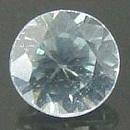|
|
|
|
Click on a letter above to view the list of gems. |
|
|
|
|
|
Reidite |
|
| Chemistry: Zr(SiO4) [Zirconium Silicate] | |
| Discovered
in 2001;
IMA
status: Valid (IMA approved 2001). | ||
|
| ||
|
Classification |
|
|
| |
|
Silicates | |
|
8/A.09-15 | |
|
|
9 : SILICATES (Germanates) |
|
Related to: |
Zircon - Thorogummite Series. A high-pressure polymorph of Zircon with the Scheelite structure. |
|
|
|
|
Crystal Data |
|
|
|
|
|
Skeletal crystals up to 10 Ám in length and 0.3 Ám in width. |
|
|
None |
|
|
|
|
|
Physical Properties |
|
|
|
|
|
None Observed |
|
|
Irregular/Uneven |
|
|
Brittle |
|
|
7.5 |
|
|
5.2 (g/cm3) |
|
|
None |
|
|
Not Radioactive |
|
|
|
|
|
Optical Properties |
|
|
|
|
|
Colorless, White |
|
|
Transparent to Translucent |
|
|
Adamantine |
|
|
1.640 - 1.655 Uniaxial ( + ) |
|
|
0.0150 |
|
|
n/a |
|
|
None |
|
|
|
|
|
Occurances |
|
|
|
|
|
Geological Setting: |
In upper Eocene impact ejecta layer, probably from the Chesapeake Bay impact structure in shock-metamorphosed Zircons. |
|
Common Associations: |
Coesite, Shocked Feldspar, Shocked Quartz, Stishovite, Tektites |
|
Common Impurities: |
Coesite, Stishovite |
|
Type Locality: |
Deep Sea Drilling Project Site 612, Upper continental slope of New Jersey, Atlantic Ocean |
|
Year Discovered: |
2001; IMA approved 2001 |
|
|
|
|
More Information |
|
|
|
|
|
| |
|
|
|
|
|
|
|
We
have not photographed our Reidite gems. Please
check back soon. |
